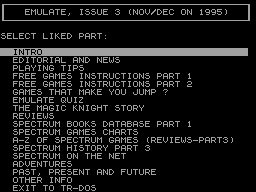|
#03
31 октября 1995 |
|
Part 11 - Spectrum history (part 3).

==========================================
****************************************
* PART 11 - SPECTRUM HISTORY PART 3 *
****************************************
Continuing our series looking back at the
History of Sir Clive and the Sinclair
Computers, we head back to 1987 and take a
look at what Crash thought of the first
new Sinclair machine since the Amstrad
buyout - the Z88.
SINCLAIR'S Z88 - Pandora's Box?
Review taken from Crash #39 - April 1987
GENESIS
Uncle Clive has been plugging the idea of
a portable machine since he first began
making computers - in fact, his first
computer concept, the NewBrain, was a
portable machine. That was orignally
developed in 1978 by his old firm,
Sinclair Radionics. Later it was sold off
to Newbury Laboratories, who launched it
to an indifferent world in 1982.
As Radionics collapsed at the end of the
seventies, Clive Sinclair set up a new
firm, Science of Cambridge, with Chris
Curry, a star employee from his previous
firm. When Radionics finally bit the dust,
Science of Cambridge was renamed twice -
first to Sinclair Computers and then to
Sinclair Research. No-one was the
slightest bit surprised at this, as
Science of Cambridge advertisements looked
exactly the same as theirearlier Radionics
counterparts. The Sinclair link had been
obvious all along.
RECURRENT THEMES
Clive has now sold his surname to Amstrad,
but that doesn't stop him putting CLIVE
SINCLAIR (without the 'Sir') in large type
at the top of the first page of the Z88
brochure. The leaflet follows the usual
Sinclair format, just as the new company
name follows on from previous titles.
Cambridge Computer seems to be run on
something of a showstring. The Z88 was
first revealed at a lunch for journalists
at Sir Clive's house in London. Two days
later a prospective customer arrived at
the firm's Which Computer Show stand, and
asked the name of the Sales Director. He
was told, apologetically, that they hadn't
got one!
Chris Curry has evidently been impressed
by the ease with which Sinclair has kept
the ball rolling from one firm to another.
Curry set up his own company in 1979 -
Acorn Computers - and he duly left Uncle
Clive after the ZX-80, to work full time
on his own. Acorn, like Radionics and
Sinclair Research, had it's ups and downs
and was eventually bailed out by Olivetti.
Curry abandoned ship, but he's still in
the game - he's the man behind the Red Box
add-ons which we reviewed in the Christmas
Special.
MORE PRE-HISTORY
Science of Cambridge avoided portable
machines at first. They produced a tiny
bare-board computer called the MK14, and
then the ZX-80 - the first useful looking
computer to sell for under ▄▒00. The
design of the Spectrum ROM is closely
allied to that of the ZX-80 with the
ZX-81 - which actually was useful - as an
intermediate step between the two
machines.
In 1980 we were told that the ZX-80 "would
be linked to a flat screen display." In
May of 1981 Sinclair upgraded his promise,
announcing a version of the ZX-81 with a
"four or five inch flat screen", scaled up
from the Radionics pocket TV display...it
never turned up - even in protoype form.
In 1983 the QL was planned as a
go-anywhere machine, with space for a
column of U2 batteries along the back of
the case. Portability went out of the
window in the rush to get something on to
the shelves, as the bottom began to drop
out of the micro market.
GENESIS REVISITED
A design recognisably similar to that of
the Z88 was born early in 1984, partly in
an attempt to salvage ideas left over from
the development of the QL and the LC-3.
The low cost LC-3 was the first,
unreleased Super-Spectrum. It was scrappe
in 1982, when a follow up didn't seem
necessary, and Sinclair Research turned to
grander designs.
The details of the planned portable were
published in February 1985, and it was
scheduled for launch "in 1986". At this
stage the machine was based around the
Spectrum design, with a Z80 processor and
support for Spectrum software. Built-in
business packages were promised, along
with "bank switched" plug-in memory
cartridges. SA "proper light up display",
again derive from the pocket TV, was
considered essential.
"Liquid Crystal is rubbish", Sir Clive
explained. "Nobody pursuing that avenue is
getting anywhere. Nobody in the world has
an answer to the flat display problem -
except us."
PANDORAS BOX
After a massive development effort,
Sinclair engineers did manage to scale up
the Microvision display, but the result
was not judged a great success. The new
screen used a combination of lenses and
mirrors to project a picture in the air
between the lid and the base of the
prototype machine. The idea was ingenious,
and it worked after a fashion - but it was
heavy, greedy for power, fragile, and
ill-suited to mass production...and that's
being kind! This machine was dubbed
"Pandora" inside the company. Like that of
the "Loki" proposal which I demolished in
August 1986, this name was rather an
obscure joke. According to ancient myth,
Pandora was a character who made the
mistake of opening the box in which all
the evils of the world were trapped, along
with one more benign quality - hope.
Opening the Pandora computer case could
have released just about anything!
Under the termes of his sell-out, Sinclair
is required to offer future computer
designs to Amstrad. One look at Pandora
was enough to put them off - the gave
Sinclair permission to go it alone.
Continued Next Issue...
==========================================
Другие статьи номера:
Похожие статьи:
В этот день... 13 ноября